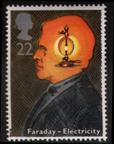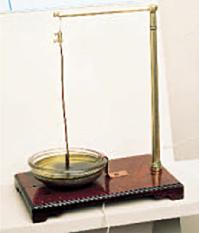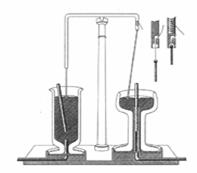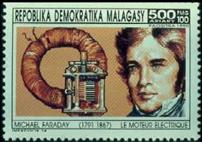
 Handout #22 - Michael Faraday
Handout #22 - Michael Faraday
English physicist and chemist
Born: Newington, Surrey, September 22, 1791
Died: Hampton Court, near London, August 25, 1867
 Michael Faraday discovered many of the fundamental laws of physics and chemistry, despite the fact that he had virtually no formal education. The son of an English blacksmith, he was apprenticed at the age of 14 to a bookseller and bookbinder. He read every book on science in the bookshop and attended lectures given at the Royal Institute by various scientists, including Sir Humphrey Davy, the discoverer of 12 chemical elements. In 1812, he applied to Davy for a job, citing his interest in science and showing Davy the extensive lecture notes he had taken. Davy hired Faraday to assist with his research and lecture demonstrations.
Michael Faraday discovered many of the fundamental laws of physics and chemistry, despite the fact that he had virtually no formal education. The son of an English blacksmith, he was apprenticed at the age of 14 to a bookseller and bookbinder. He read every book on science in the bookshop and attended lectures given at the Royal Institute by various scientists, including Sir Humphrey Davy, the discoverer of 12 chemical elements. In 1812, he applied to Davy for a job, citing his interest in science and showing Davy the extensive lecture notes he had taken. Davy hired Faraday to assist with his research and lecture demonstrations.
Within a few years, Faraday began to do original research on his own, submitting two papers on chemistry to the Royal Society in 1820. In that same year, Oersted discovered that a current in a wire will deflect a compass needle. Faraday repeated Oersted's experiments and found that a magnet also exerts a force on a wire carrying an electric current. Soon afterward, he also showed how to liquefy chlorine, and he isolated benzene, a compound now widely used in chemical products.
 Faraday's important discoveries brought him considerable fame, much to the discomfort of Davy, who felt he should have shared the credit for some of the advances. Davy preferred to regard Faraday as a technical assistant and even forced him to serve as a valet on an extended tour of European research centers. Despite Davy's objections, Faraday was elected to the Royal Society in 1824 and was made director of the laboratory at the Royal Institute in 1825.
Faraday's important discoveries brought him considerable fame, much to the discomfort of Davy, who felt he should have shared the credit for some of the advances. Davy preferred to regard Faraday as a technical assistant and even forced him to serve as a valet on an extended tour of European research centers. Despite Davy's objections, Faraday was elected to the Royal Society in 1824 and was made director of the laboratory at the Royal Institute in 1825.
 After Faraday discovered, in 1831, that a changing magnetic field can induce a current, he performed a series of experiments that showed clearly that the induced EMF (voltage) is equal to the rate of change of magnetic flux. Also, generalizing from the patterns formed by iron filings around magnets, he invented the concepts of magnetic and electric field lines. Faraday knew little mathematics and found this concrete approach to electricity and magnetism much more useful than equations giving the forces between charges or currents. He also suggested that the propagation of light through space consisted of vibrations of these lines. His concepts of electric and magnetic fields were put into a mathematical form a generation later by Maxwell, who showed that light is, in fact, an oscillatory electromagnetic disturbance.
After Faraday discovered, in 1831, that a changing magnetic field can induce a current, he performed a series of experiments that showed clearly that the induced EMF (voltage) is equal to the rate of change of magnetic flux. Also, generalizing from the patterns formed by iron filings around magnets, he invented the concepts of magnetic and electric field lines. Faraday knew little mathematics and found this concrete approach to electricity and magnetism much more useful than equations giving the forces between charges or currents. He also suggested that the propagation of light through space consisted of vibrations of these lines. His concepts of electric and magnetic fields were put into a mathematical form a generation later by Maxwell, who showed that light is, in fact, an oscillatory electromagnetic disturbance.
 Faraday made many other notable contributions. He devised the first electrical generator, which consisted of a copper disk rotating between the poles of a magnet. He discovered the correct laws of electrochemistry after proving that earlier theories disagreed with experiments. He studied optical phenomena and found that when light passes through a medium, a magnetic field will rotate the direction of the oscillating electric field. Ignoring scorn from his contemporaries, he attempted unsuccessfully in laboratory experiments to find a link between gravitation and electromagnetism. Such a link was observed 70 years later in a test of Einstein's general theory of relativity, when light rays passing near the sun were found to be deflected.
Faraday made many other notable contributions. He devised the first electrical generator, which consisted of a copper disk rotating between the poles of a magnet. He discovered the correct laws of electrochemistry after proving that earlier theories disagreed with experiments. He studied optical phenomena and found that when light passes through a medium, a magnetic field will rotate the direction of the oscillating electric field. Ignoring scorn from his contemporaries, he attempted unsuccessfully in laboratory experiments to find a link between gravitation and electromagnetism. Such a link was observed 70 years later in a test of Einstein's general theory of relativity, when light rays passing near the sun were found to be deflected.
 Despite his achievements, Faraday remained a modest and humble person. He declined to be knighted or to receive honorary degrees and only reluctantly accepted a small pension on his retirement in 1858.
Despite his achievements, Faraday remained a modest and humble person. He declined to be knighted or to receive honorary degrees and only reluctantly accepted a small pension on his retirement in 1858.